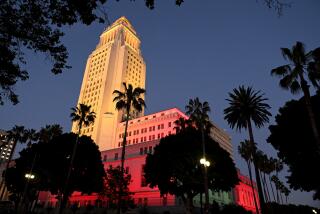Neighborhood Councils Flexing Muscle
- Share via
When dozens of neighborhood council leaders trooped to the microphone in the Los Angeles City Council chambers Jan. 14 to complain about the Police Department’s new burglar alarm policy, several council members heralded their presence as a turning point in the evolution of local government.
For the first time since voters approved the creation of the neighborhood groups in 1999, members of the nascent organizations packed City Hall to speak out on an issue, and the council promised to listen.
Yet the neighborhood leaders complained that they were there because they had been left out when the Police Commission voted to end police response to unverified alarms.
Behind the debate about the merits of the alarm policy lies a more protracted problem: the growing pains afflicting City Hall as it tries to incorporate into its decision-making the 61 neighborhood councils that have sprouted up citywide.
“This is a learning curve we’re on now,” Mayor James K. Hahn said. “It does point out we’ve got a lot of room for improvement here and a long way to go to make sure every department is thinking” about neighborhood councils.
One of the city’s biggest challenges is creating an effective system to give neighborhood councils notice of all issues that come before city government, as mandated by the new City Charter.
“Notification is crucial for neighborhood councils to succeed,” said USC professor Erwin Chemerinsky, who helped draft the charter. “If neighborhood councils don’t have a way of knowing what’s coming up, then they won’t have the opportunity to play the only role they have under the charter.”
That role is to advise city officials of their views on various issues.
But the charter does not specify what issues the local councils should be notified about -- or how. Do they need to know about every land-use decision before the regional planning boards? The contracts approved by the Board of Airport Commissioners? What about motions before the City Council to extend city leases or appropriate extra money to departments?
“The volume of stuff is just staggering,” said Greg Nelson, general manager of the Department of Neighborhood Empowerment, which is responsible for organizing and supporting the neighborhood councils.
Currently, the only way the public is notified about issues before the City Council, city commissions and council committees is through the city’s Web site -- www.cityofla.org, where people can sign up to receive the agendas of those bodies by e-mail.
But officials acknowledge that the technical language used on city agendas may prevent many people from understanding the significance of an issue.
For example, when the Police Commission was considering the proposal to end responses to unverified alarms, Item 5A on the panel’s Dec. 17 agenda read: “Discussion and consideration of reports relative to dispatch policy for Verified Burglary Alarms, as set forth.”
“If you saw that, would you know that meant the police were no longer going to respond to unverified alarms?” Nelson asked.
Another challenge is the timeliness of the notice. Most agendas are sent out just 72 hours before a meeting, as required by law. But that doesn’t give residents much chance to disseminate the information to their neighbors, much less to assemble a local council to vote on an issue.
“It hasn’t evolved to the point where I think it’s effective,” said Jim Leahy, interim chairman of the Van Nuys neighborhood council.
Despite the problems, there is evidence that City Hall is slowly adjusting.
The city’s Information Technology Agency is working on a second phase of the e-mail notification system that would allow people to filter the agendas they receive by geographic area or by topic. They also are studying how to make staff reports to the council available on-line.
To assist those who lack access to the Internet, the Department of Neighborhood Empowerment is providing a free computer and modem for each neighborhood council. Each group can then decide how it wants to disseminate information to its members.
The Planning Department is sending the neighborhood groups a list of upcoming projects, and the regional planning commissions are sending the organizations hearing notices for new developments in their areas.
“It’s a culture change,” Nelson said. “The city used to simply be satisfied with doing things on their own, and not telling a lot of people about it.... But I think we’re going to see more and more of the city opening up in this way and involving people in the decisions they make.”
Next week, the council will consider a motion by Councilwoman Janice Hahn requiring, among other measures, that the council, committees and commissions post advance agendas and provide information about upcoming issues and that they use clear and understandable language in describing agenda items.
A North Hollywood resident, Diann Carroll, said she sees a difference in the city’s communications with residents.
Her Mid-Town North Hollywood neighborhood council gets regular reports from the planning deputies for council members Wendy Greuel and Tom LaBonge.
When a Sav-On drugstore was going up in the area, a planning deputy brought the developer to meet the neighbors, who persuaded him to plant larger trees, extend the curfew on liquor sales and install a bike rack. Local residents were thrilled, Carroll said.
“They’re listening,” she said. “Some people still aren’t satisfied with the amount of attention. But I keep saying, this is just the beginning.”
More to Read
Sign up for Essential California
The most important California stories and recommendations in your inbox every morning.
You may occasionally receive promotional content from the Los Angeles Times.













